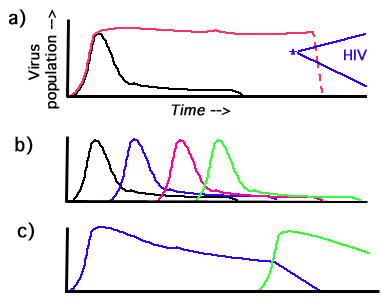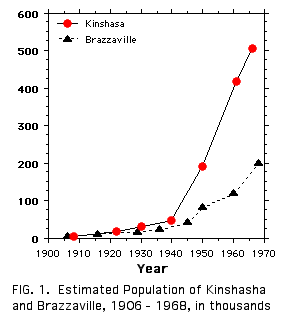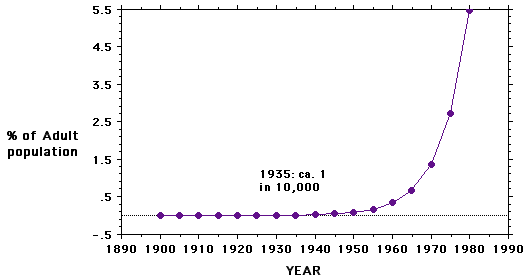10 May 2001
Another "new bit" -- there have been several developments re the debate over HIV's origins.
- First, a series of papers reporting the absence of any HIV, SIV, or chimpanzee DNA in the remnants of Koprowski's OPV
- These have been heralded as "disproving" the OPV hypothesis; since there is always the possibility that SIVcpz contaminated some batch that didn't happen to be preserved, the results do not disprove anything. They do further reduce the likelihood that the OPV hypothesis is correct.
- Berry, N. et al. (2001). Analysis of oral polio vaccine CHAT stocks. Nature. 410: 1046-1047.
- Blancou, P. et al. (2001). Polio vaccine samples not linked to AIDS. Nature. 410: 1045-1046.
- Poinar, H., Kuch, M. & Paabo, S. (2001). Molecular Analyses of Oral Polio Vaccine Samples. Science. 292: 743-744.
- Rambaut, A., Robertson, D. L., Pybus, O. G., Peeters, M. & Holmes, E. C. (2001). Phylogeny and the origin of HIV-1. Nature. 410: 1047-1048.
- Second, Preston Marx & colleagues have published a detailed presentation of the theory that HIV originated post-WWII via unsterile disposable needles
Marx, P. A., Alcabes, P. G. & Drucker, E. (2001). Serial human passage of simian immunodeficiency virus by unsterile injections and the emergence of epidemic human immunodeficiency virus in Africa. Phil. Trans. R. Soc. Lond. B. 356: 1-9. -
Marx et al. point out that the probability of spontaneous mutation from SIV to HIV is a function of viral population size, and that since "[n]ormally, human host defences would suppress poorly adapted SIV strains", some mechanism must be found to permit the SIV to remain at high levels in the new host for long enough that such a spontaneous mutation might occur (where "long enough" is on the order of months, and normal immune suppression of unfit virus is on the order of 1-2 weeks). Visually, in (a) SIV titres have to be high for a long time (red curve) to have a realistic chance of mutating to HIV, but normally they are suppressed (black curve) too soon. The suggested mechanism is serial passaging of virus via unsterile needles, which they tie to the postwar introduction of disposable syringes. High viral population levels are maintained (through a series of bottlenecks) in a series of different individual hosts (figure b).
Chitnis et al. postulate a slightly different mechanism, that of immune suppression due to chronic stress associated with colonial labor camps etc. plus a much lower rate of serial passage via unsterile needles or arm-to-arm vaccination (figure c).

The two papers (Marx et al. and Chitnis et al.) postulate similar mechanisms for the origin of HIV but place the critical events and immediate causes in two very different time periods. In this connection there is a glaring discrepancy between our papers concerning the history of injections in Africa during the colonial period. I do not fully understand the basis for the discrepancy, so only note it here.
Marx et al. provide a table of "History of injectable medications and needle reuse in Africa, 1900-1998", in which the only entry prior to 1920 is for treatment of syphilis, 1900-1920, and it is stated that this "antedates awareness of transmission of infectious diseases by unsterile injections". They also state that prior to WWII injectable drugs were administered "on site and under medical supervision, while closely controlling access to the relatively costly drugs and injecting equipment (UNICEF 1987), using sterile injecting procedures and with access to sterilization equipment on hand. There is little evidence of injection-related transmission of disease in the pre-WWII colonial period (Alland 1970)." [p. 6]. The only indications they list prior to 1952 are syphilis, diabetes and VD.
In total and complete contrast, Headrick (1994) presents tables of numerous specific vaccination campaigns against smallpox and other diseases prior to 1920. For example, Table 3.8 (p. 65) lists 19 separate documented smallpox vaccination campaigns in French Equatorial Africa between 1893 - 1912; the total vaccinated in the 15 for which numbers are available is 82,091. She then states, "In addition, continual vaccination of recruits and porters went on and doctors, missionaries, and sometimes administrators carried out informal, small-scale vaccination tours in their immediate surroundings. Compared to French West Africa, where 1,003,000 vaccinations were performed in 1911 alone, the figures for French Equatorial Africa are not impressive (Delrieu 1914, 375)." [p. 66]. In addition there were (according to Headrick) massive campaigns against sleeping sickness and bacillary dysentery during the 1920s. As to the qualifications and supervision of people administering injections, see Headrick pp. 241-253. One illustrative quote: "Most white missionaries, administrators, company agents, army nurses, agents sanitaires, and hygienistes adjoints went well beyond what their occupations permitted. All dispensed drugs, gave injections, made diagnoses, or performed minor surgery without the direct supervision of a doctor." [p. 244]. As to awareness that unsterile injections could carry disease, Headrick notes e.g. that in 1920, nurses (local technicians) in the sleeping sickness campaigns were trained in "concrete operations: sterilizing water, instruments, and the skin, cleaning slides and ... giving injections. These courses lasted from 4 to 8 weeks." [p. 246; she notes this was the only formal training course for local nurses given at the time.] See also Copeman (1899) for a contemporary discussion of the importance of sterile instruments.
I have no idea how to reconcile these two images of colonial medical practice. For the interested reader, here are the references cited above:
- Alland, A. (1970). Adaptation in cultural evolution: an approach to medical anthropology. New York: Columbia University.
- Copeman, S. M. (1899). Vaccination, its natural history and pathology. London: Macmillan.
- Delrieu. (1914). Organisation du Service de sante en Afrique occidentale francaise (Extrait de Rapport medical annuel 1911). Annales d'hygiene et de medecine colonialies. 17: 349-375.
- Headrick, R. & Headrick, D. R. E. (1994). Colonialism, Health and Illness in French Equatorial Africa, 1885-1935. Atlanta: African Studies Association Press.
- UNICEF. (1987). UNICEF in Africa south of the Sahara: a historical perspective. UNICEF History Series, monograph VI.. UNICEF.
 2) VIRAL TRANSMISSION: There was a massive influx of
people into the major cities following WW II, constituting "... movement of
previously isolated people into the newly expanding cities"
2) VIRAL TRANSMISSION: There was a massive influx of
people into the major cities following WW II, constituting "... movement of
previously isolated people into the newly expanding cities"  Suppose: a single person is infected, and on average transmits the virus to 2 people over the next 5 years. Given obvious uncertainties about sexual practices, infectability etc. this is very rough; I am assuming here that if the virus originally transferred during a hunting/butchery episode, the early years are in rural, small-village settings; prostitution was not a factor early on. Basically, I'm postulating a doubling every 5 years. What does that look like?
Suppose: a single person is infected, and on average transmits the virus to 2 people over the next 5 years. Given obvious uncertainties about sexual practices, infectability etc. this is very rough; I am assuming here that if the virus originally transferred during a hunting/butchery episode, the early years are in rural, small-village settings; prostitution was not a factor early on. Basically, I'm postulating a doubling every 5 years. What does that look like?